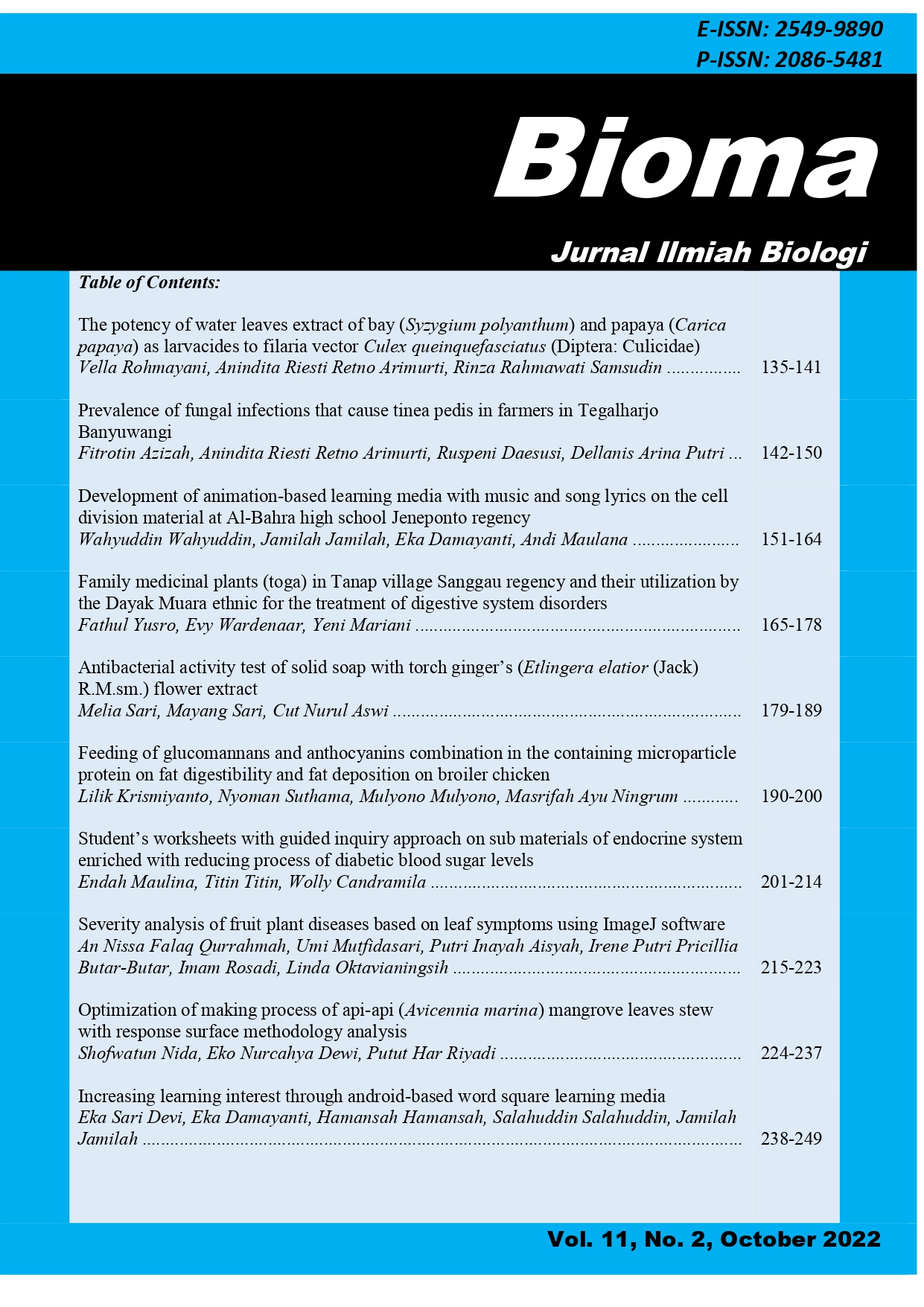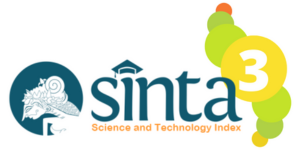POTENTIAL IMPLEMENTATION OF ETHNOSCIENCE-ORIENTED LEARNING ON BIOTECHNOLOGY MATERIAL
DOI:
https://doi.org/10.26877/h1m2ct96Keywords:
Biotechnology, Contextual Learning, Ethnoscience, Science EducationAbstract
There are still many science learning practices that focus on memorization and do not relate the subject matter to real life or the local cultural context of students. Science is often perceived as a difficult and boring subject because it relies heavily on technical terms and abstract material. This study aims to explore the potential implementation of ethnoscience oriented learning in biotechnology material at the junior high school level. Data were collected through interviews with 11 science teachers from Sub Rayon 05 of Grobogan Regency and classroom observations involving 3 peer teachers at SMP Negeri 1 Ngaringan. The interview was conducted using a Google Form-based questionnaire, while observation data were obtained through direct observation using a structured observation sheet. The results showed that teachers had a good understanding of ethnoscience (78.7%), and the potential for implementation was considered very high (84%). However, curriculum development remained the lowest aspect observed (67%). These findings indicate that while the conceptual understanding and enthusiasm of teachers toward ethnoscience are strong, effective implementation requires systemic support, training, and curricular alignment.
References
Achadah, A. (2019). Strategi guru dalam meningkatkan motivasi belajar siswa pada mata pelajaran Pendidikan Agama Islam Kelas VIII di SMP Nahdhotul Ulama’ Sunan Giri Kepanjen Malang. Jurnal Darussalam: Jurnal Pendidikan, Komunikasi Dan Pemikiran Hukum Islam, 10(2), 363. https://doi.org/10.30739/darussalam.v10i2.379
Amin, S., Utaya, S., Bachri, S., Sumarmi, & Susilo, S. (2020). Effect of problem-based learning on critical thinking skills and environmental attitude. Journal for the Education of Gifted Young Scientists, 8(2), 743–755. https://doi.org/10.17478/jegys.650344
Ardianti, S. D., & Raida, S. A. (2022). The Effect of Project Based Learning with Ethnoscience approach on science conceptual understanding. Journal of Innovation in Educational and Cultural Research, 3(2), 207–214. https://doi.org/10.46843/jiecr.v3i2.89
Arega, N. T., & Hunde, T. (2025). Constructivist instructional approaches: A systematic review of evaluation‐based evidence for effectiveness. Review of Education. https://doi.org/10.1002/rev3.70040
Asra, A., Festiyed, F., Mufit, F., & Asrizal, A. (2021). Pembelajaran Fisika mengintegrasikan Etnosains permainan tradisional. Konstan - Jurnal Fisika dan Pendidikan Fisika, 6(2), 66–73. https://doi.org/10.20414/konstan.v6i2.67
Dewanti, B. A., Santoso, A., Education, S., Program, S., Training, T., & Faculty, E. (2020). Development of 21 st Century Learning Skills Assessment Instruments in STEM-Based Science Learning ( Science , Technology , Engineering , and Mathematics ). 8(2), 99–111.
Dila Oktaviani, D., & Gusmaneli, G. (2024). Pemanfaatan umpan balik dalam perbaikan kurikulum pembelajaran IPA. Jurnal Inovasi Pendidikan, 14(1), 55–65.
Farrell, T. S. C. (2018). Reflective Practice for Language Teachers. Equinox Publishing.https://api.semanticscholar.org/CorpusID:150523659
Gummah, S., Fitri, M., Prayogi, S., & Asy’ari, M. (2023). The Effects of Ethnoscience Integrated Problem-Based Learning Models on Students’ Critical Thinking Skills. Lensa: Jurnal Kependidikan Fisika, 11(2), 54. https://doi.org/10.33394/j-lkf.v11i2.10447
Hadi, S., & Ahied, M. (2017). Pembelajaran sains berbasis kearifan lokal. Jurnal Pendidikan IPA Indonesia, 6(2), 234–241.
Haryanto, T., & Kencanawati, I. (2023). Improving Critical Thinking Skills of Prospective Biology Teacher Students through Ethnoscience-Based Biology Learning. Tarbawi : Jurnal Ilmu Pendidikan, 19(1), 13–24. https://doi.org/10.32939/tarbawi.v19i1.2601
Hendry, A., Hays, G., Lynch, D. J., & Challinor, K. (2016). Enhancing student learning through Project Based Learning (PBL) in a secondary school integrative STEM course. https://api.semanticscholar.org/CorpusID:187996471
Indrawati, M. (2017). Keefektifan Lembar Kerja Siswa (LKS ) berbasis Etnosains pada materi Bioteknologi untuk melatih keterampilan proses sains siswa Kelas IX.PENSA E-Jurnal : Pendidikan Sains, 5 (2), https://ejournal.unesa.ac.id/index.php/pensa/article/view/18911
Ismail, I. A., Mawardi, Kurniawati, D., Arif, K., & Nofrialdi, R. (2024). Dari warisan leluhur ke laboratorium modern : Etnosains mewarnai pembelajaran IPA. LPPM AAI Padang.
Lidi, M. W., Mbia Wae, V. P. S., & Umbu Kaleka, M. B. (2022). Implementasi Etnosains dalam pembelajaran IPA untuk mewujudkan Merdeka Belajar di Kabupaten Ende. OPTIKA: Jurnal Pendidikan Fisika, 6(2), 206–216. https://doi.org/10.37478/optika.v6i2.2218
Liliyanti, M., Mariani, Y., & Yusro, F. (2021). Pemanfaatan tumbuhan obat untuk perawatan rambut oleh Suku Dayak Kantuk di Desa Seluan Kabupaten Kapuas Hulu Kalimantan Barat. Bioma : Jurnal Ilmiah Biologi, 10(2), 228–247. https://doi.org/10.26877/bioma.v10i2.9019
Mardhiyah, R.H., Aldriani, S. N. F., Chitta, F., & Zulfikar, M. R. (2021). Pentingnya keterampilan belajar di Abad 21 sebagai tuntutan dalam pengembangan sumber daya manusia. Lectura : Jurnal Pendidikan, 12 (1), 29-40. https://doi.org/10.31849/lectura.v12i1.5813
Massita, N., et al. (2016). Integrasi pendidikan karakter dalam pembelajaran berbasis etnosains. Jurnal Pendidikan Karakter, 6(2), 123–134.
Miaz, Y., Erwin, R., Helsa, Y., Syahniar, S., & Ifdil, I. (2019). Interactive multimedia-based map media development. Journal of Physics: Conference Series, 1318(1). https://doi.org/10.1088/1742-6596/1318/1/012032
Mukti, H., Suastra, I. W., & Aryana, I. B. P. (2022). Integrasi Etnosains dalam pembelajaran IPA. JPGI (Jurnal Penelitian Guru Indonesia), 7(2), 356–362.
Nadiyah, Mardiana, Wahyu Iskandar, & Fia Alifah Putri. (2022). Problem Based Learning (PBL) berbasis etnosains dan etnomatematik. Al-Ihtirafiah: Jurnal Ilmiah Pendidikan Guru Madrasah Ibtidaiyah, 2(2), 275–284. https://doi.org/10.47498/ihtirafiah.v2i02.1338
Novitasari, L., Agustina, P. A., Sukesti, R., Muhammad, N., & FaizalHandhika, J. (2017). Fisika, Etnosains, dan Kearifan Lokal dalam Pembelajaran Sains. Seminar Nasional Pendidikan Fisika III 2017, 81–88.
Nwosu, A. A. (2017). Effect of Ethnoscience andtraditional Laboratory Practical on Science Process Skill Acquisitionof Secondary School 1(1), 10–21.
Oktaviani, D., & Gusmaneli, G. (2024). Strategi umpan balik sebagai alternatif strategi pembelajaran. Al-Tarbiyah : Jurnal Ilmu Pendidikan Islam, 2(4), 349–354. https://doi.org/10.59059/al-tarbiyah.v2i4.1482
Pradita, S., Mariani, Y., Wardenaar, E., & Yusro, F. (2021). Pemanfaatan tumbuhan obat oleh Suku Dayak Paus dan Melayu untuk perawatan ibu dan anak pasca persalinan di Desa Pengadang Kabupaten Sanggau Kalimantan Barat. Biodidaktika: Jurnal Biologi dan Pembelajarannya, 16(1). https://doi.org/10.30870/biodidaktika.v16i1.10805
Rahayu, W. E., & Sudarmin. (2015). Pengembangan modul IPA Terpadu berbasis Etnosains tema energi dalam kehidupan untuk menanamkan jiwa konservasi siswa. Unnes Science Education Journal, 4(2). https://doi.org/10.15294/usej.v4i2.7943
Rahmawati, H., Pujiastuti, P., & Cahyaningtyas, A. P. (2023). Kategorisasi kemampuan berpikir kritis siswa kelas empat Sekolah Dasar di SD se-Gugus II Kapanewon Playen , Gunung Kidul. Jurnal Pendidikan dan Kebudayaan, 8 (1), 88–104. https://doi.org/10.24832/jpnk.v8i1.3338
Ramadan, R. R., Safei, S., Damayanti, E., & Jamilah, J. (2021). Strategi belajar overlearning menggunakan media edmodo dapat meningkatkan motivasi belajar biologi peserta didik. Bioma : Jurnal Ilmiah Biologi, 10(1), 30–43. https://doi.org/10.26877/bioma.v10i1.7176
Ramadhani, W. S., Azizah, U., & Nasrudin, H. (2024). Project-Based Learning on Critical Thinking Skills in Science Learning: Meta-analysis. SAR Journal - Science and Research, 7(2), 136–142. https://doi.org/10.18421/sar72-10
Regina, B. D., & Wijayaningputri, A. R. (2022). Kajian etnosains berbasis kearifan lokal pada karya seni batik tulis di Anjani Batik Galeri Bumiaji. JOTE : Journal on Teacher Education, 4 (2), 484–490.
Sarkingobir, Y., & Bello, A. (2024). Enhancing critical thinking through Ethnoscience-Integrated Problem-Based Learning : a comparative study in Secondary Education. International Journal of Ethnoscience and Technology in Education, 1(1), 1. https://doi.org/10.33394/ijete.v1i1.10878
Siswanto, S., Trisnowati, E., Firmadani, F., Haryati, S., Aryanti, D., & Andrianto, H. N. (2020). Workshop on Inquiry Learning Based Virtual Laboratory in Magelang for preparing natural science teacher in 21st Century: an Evaluation of Implementation's Program. Indonesia Journal of Education and Learning, 3(2), 367–373. https://doi.org/10.31002/ijel.v3i2.3036
Sudarmin, S., Mursiti, S., & Asih, A. G. (2018). The use of scientific direct instruction model with video learning of ethnoscience to improve students’ critical thinking skills. Journal of Physics: Conference Series, 1006(1). https://doi.org/10.1088/1742-6596/1006/1/012011
Telehala, N., & Purba, J. W. (2020). Strategi belajar siswa kelas VI untuk menghadapi Ujian Akhir Sekolah (UAS) pada SDN 3 Kairatu Kabupaten Seram bagian barat. DIDAXEI : Jurnal Pendidikan, 1(1), 12-19
Trilling, B., & Fadel, C. (2009). 21st Century Skills: Learning for Life in Our Times. San Francisco, CA: Jossey-Bass.
Utaminingsih, S., Rihayati, R., & Santoso, S. (2021). Improving the critical thinking skills by using the Discovery Learning model based on the Ethnoscience of the Patiayam Site. Proceedings of the Second Asia Pacific International Conference on Industrial Engineering and Operations Management, 3638–3650.
Yusro, F., Mariani, Y., & Wardenaar, E. (2021). The Utilization of medicinal plants to cure gastrointestinal disorders by The Dayak Muara Tribe in Kuala Dua Village, Sanggau Regency. Jurnal Biologi Tropis, 21(2), 416–426. https://doi.org/10.29303/jbt.v21i2.2638








